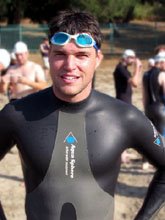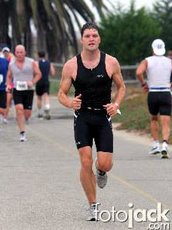Here’s one of my favorites, Myth #5,236: “I need to lose fat. So I need to do aerobics, not weight training.”
As with most myths, there’s a grain of truth in there: aerobic exercise does burn fat, readily and directly, and that’s why for many years—up to and including today—researchers recommended steady-state, easy aerobic exercise for weight control. They would suggest you go out for a walk with a friend and if you can carry on a conversation, you’re happily in the ‘fat-burning zone.’
There’s nothing WRONG with that advice, exactly—it’s safe and it’s supported by research about health and exercise. But it’s not the whole picture. In fact, it may very well be that the most time-effective way to burn fat is not steady-state aerobic work but its meaner, tougher cousin, heart-pounding, muscle-building anaerobic exercise.
Now I don’t want to slag off your standard aerobic workout. Steady-state aerobic work is great for your cardiovascular system, and it certainly burns fat, but it does so almost exclusively DURING exercise, and even then not until after almost 20 minutes of work—about the time most of us are already in cool-down mode. Following exercise, the metabolism does not stay elevated for an appreciable period. In order to get that post-exercise fat burn, you’ve got to work anaerobically—and for fat-loss, post-exercise fat burn is where it’s at.
If you don’t believe me, take a look at some recent stars of track and field: you’ve got your long-distance runners, your middle-distancers, and your sprinters. It’s reasonable to assume that they’re all spending the bulk of their training hours abiding carefully by the SAID principle (Yes, my tips are cumulative!), and thus doing mostly long, middle, and short distances, respectively. Now, if today’s myth is true—that only aerobic work burns fat—the long distance guys should be lean, the middle-distancers mildly flabby, and the sprinters downright chubsters.
But it ain’t so.

 I mean, c’mon—you could lose a purse full of change in the cuts in 100-meter-dasher Maurice Green’s abs. And middle distance queen Marion Jones makes Angela Bassett look like a pre-surgery Al Roker. These folks are lean, mean, anaerobic machines. In fact, for my money, they look better than their long-distance cousins, whose names I don’t know because let’s face it, I’m less impressed by their emaciated physiques. Sprinters look great, and what they do seems exciting and sexy by comparison with the plodding, dogged long-distance guys (I’m a long-distance dabbler myself and thus allowed to say such things). Shallow? Yes! In agreement with most of the Olympic-watching population? Absolutely!! Off on an irrelevant tear about physical aesthetics in the early 21st century? YES!
I mean, c’mon—you could lose a purse full of change in the cuts in 100-meter-dasher Maurice Green’s abs. And middle distance queen Marion Jones makes Angela Bassett look like a pre-surgery Al Roker. These folks are lean, mean, anaerobic machines. In fact, for my money, they look better than their long-distance cousins, whose names I don’t know because let’s face it, I’m less impressed by their emaciated physiques. Sprinters look great, and what they do seems exciting and sexy by comparison with the plodding, dogged long-distance guys (I’m a long-distance dabbler myself and thus allowed to say such things). Shallow? Yes! In agreement with most of the Olympic-watching population? Absolutely!! Off on an irrelevant tear about physical aesthetics in the early 21st century? YES!Sprinters are lean because of a phenomenon called EPOC (exercise physiology is more loaded with acronyms than the military). EPOC stands for Excess Post-Exercise Oxygen Consumption, and describes a period during which the metabolism stays revved above your base level while recovering from intense (anaerobic) exercise. During this period, your body is metabolizing lactic acid, a by-product of this type of exercise that is responsible in part for the burning sensation in your muscles towards the end of a bout of anaerobic work. The elevated metabolism requires energy (calories), and these extra burned calories, combined with those burned during the anaerobic work itself, are generally speaking GREATER than the calories required during the average session of pure, easier aerobic work. PLUS anaerobic work builds muscle more readily than aerobic work does, and muscle, as we know, looks great and burns extra calories, even at rest.
So if you’re like me and more impressed with the performance and look of the short-distance folks, why are we all emulating the exercise patterns of marathoners? Why don’t we throw in some sprint work and watch our legs and midsections transmogrify into those of a poor man’s Marion Jones or Maurice Green?
So here’s how to do it, in a nutshell: you’ve got to add some intensity to your workout. You’ve got to nudge yourself out of your comfort zone and into a place where your heart rate is really up (over 80% of maximum); your muscles burn a little, and you’re really working to catch your breath. This may take the form of a tough leg workout (see my tip from a couple weeks ago) or a set of five or six 1-2 minute fast intervals during your cardio workout, a tennis or basketball game with an opponent who keeps you running up and down the court all day, even a push or two up a steep hill on your daily jog.
Now remember: you can’t sprint all the time, and you certainly can’t start sprinting tomorrow if the most exercise you’ve gotten this year has been thumb-presses on the remote. You’ve got to build up to it. And once you’re there, you’ve got to be more careful about getting adequate rest, stretching carefully after exercise, and spacing out your workouts so you’re not risking injury. Generally I’d suggest keeping your hard-core anaerobic work down to 2-3 times per week, interspersed with rest days or sessions of steady-state training. But once you get over the initial shock of how tough sprinting can be, it’s really fun. I mean, when was the last time you ran all-out for ANY period of time for ANY reason? And why do 8-year olds do it all the time and the rest of us NEVER do?
Shoot me an email and let me know how it goes for you.
Enjoy the week. 2006 appears to be here to stay--
Andrew

 Go to just about any weight room and you’ll see a couple of extreme examples of what I’m talking about: see Günter in the corner, the 286-pound rhino bench pressing in the corner? Of course you do, that’s where the guy lives, 24-7. Well, Günter’s body has adapted to get good at bench pressing and not much else. His anterior shoulder tendons have shortened, his pectorals are as tight as a drum across his chest, his spine is misaligned from all the pushing motion he does, his core musculature is weak around his spine. Sure, Günter can bench press you and me with a couple of anorexic supermodels thrown in, but he probably can’t comb his hair, much less reach that high shelf in his closet or turn his head when he backs the car up. So, is Günter fit?
Go to just about any weight room and you’ll see a couple of extreme examples of what I’m talking about: see Günter in the corner, the 286-pound rhino bench pressing in the corner? Of course you do, that’s where the guy lives, 24-7. Well, Günter’s body has adapted to get good at bench pressing and not much else. His anterior shoulder tendons have shortened, his pectorals are as tight as a drum across his chest, his spine is misaligned from all the pushing motion he does, his core musculature is weak around his spine. Sure, Günter can bench press you and me with a couple of anorexic supermodels thrown in, but he probably can’t comb his hair, much less reach that high shelf in his closet or turn his head when he backs the car up. So, is Günter fit? People ask me all the time, "Hey Andrew," they say, "how come you always work legs so hard with your clients, even if building leg strength isn't a priority to them? I mean, what gives?" (they always add the "what gives?"). "I mean, shouldn't you be giving your clients just what they want, and no more? What kind of trainer are you, anyway?"
People ask me all the time, "Hey Andrew," they say, "how come you always work legs so hard with your clients, even if building leg strength isn't a priority to them? I mean, what gives?" (they always add the "what gives?"). "I mean, shouldn't you be giving your clients just what they want, and no more? What kind of trainer are you, anyway?" Welcome to another TIP from Dynamic Fitness. I never received any "cancel" requests, so I'm assuming that all of you are up for more of my holier-than-thou fitness counsel...for those recently added to my list, if you don't want to be included, just send me a "Cancel" in the subject line, I'll take the hint, and you can go on with your lazy, slovenly lives. I mean...er...there'll be no hard feelings.
Welcome to another TIP from Dynamic Fitness. I never received any "cancel" requests, so I'm assuming that all of you are up for more of my holier-than-thou fitness counsel...for those recently added to my list, if you don't want to be included, just send me a "Cancel" in the subject line, I'll take the hint, and you can go on with your lazy, slovenly lives. I mean...er...there'll be no hard feelings. Hey fitness clients, old, new, and 'wha--, who is this guy, and why am I opening this email?' types--
Hey fitness clients, old, new, and 'wha--, who is this guy, and why am I opening this email?' types--

